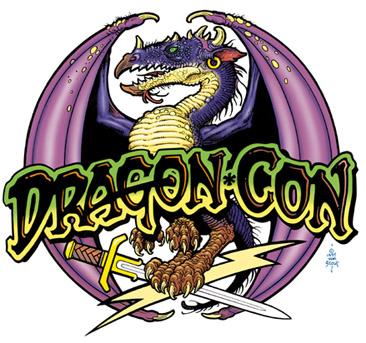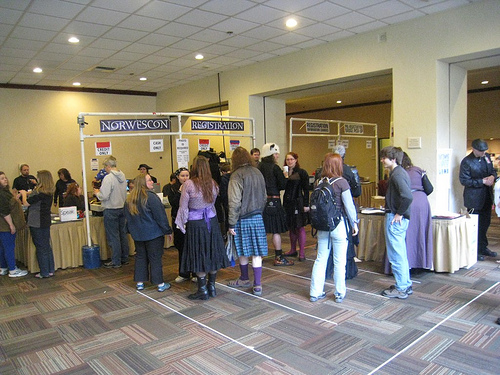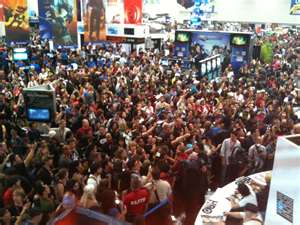I had just gotten back from Gen Con in 1993 and managed to land a job at Wizards of the Coast. The week following Gen Con was a busy one. Magic: The Gathering had taken off like a rocket, and the interest had led to a lot of activity at the WotC office. My job in those early days was basically being the office gopher. Mainly I answered the phones, sorted the mail, and ran any errands that needed to be done.
It was a flurry of activity as a lot of people wanted a piece of the Magic: the Gathering pie. And that was just the first week. At the end of that week I was asked to go to yet another convention. This time it was Worldcon, or more specifically ConFrancisco, the 51st World Science Fiction Convention.
For those not familiar with it, Worldcon is the annual convention of the World Science Fiction Society, the same group that runs the Hugo Awards for Science Fiction and Fantasy works. Worldcon is a traveling event, with a different site every year. Every Worldcon has an election for where the convention will be held two years later; this way the following year’s show can be hyped secure in knowing where it is set. A bid is submitted by a group, and if they win, they will be the primary convention organizers for that event. Each year has its own name, as they are separate events with separate organizers.
In 1993 the event was in San Francisco on the weekend of September 2-6. While Worldcon was a general Science Fiction convention with a focus on literature, it did have representation of the wider range of geek culture, including gaming. We had a small booth on the dealers’ floor and unlike Gen Con, we were not sending all the company leaders; mostly because everyone was busy and a lot of them could not be spared to go. This trip was being led by head editor Beverly Marshall Saling. The only other actual employees on the trip were myself and Dave Howell, who, as the lay out person, was also our liaison to the art department. Ron Richardson was also with us. At the time Ron was just a friend of a lot of the original staff, but would later officially join the company, first as a brand manager, and ultimately as director of logistics. There were two other people there with us, but having recently spoken with Beverly and Ron, none of us can remember who they were.
The flight to San Francisco stands out in my memory as one of the most interesting I have ever taken. Please know that it was literally the third time I had ever gotten on an airplane. I was seated next to Beverly, who was a bit of a white knuckle flyer. About an hour into the flight, we experienced what is known as wake turbulence, which is when two airplanes get too close to each other and one gets caught in the wake of the other. This caused the plane to drop several feet, and by drop I mean like going on Tower of Terror at Disneyland. For just a moment we were all weightless.
Remember how I said that Beverly was a bit of a white knuckle flyer? Do you want to take a guess how she reacted to that?
If your guess was that she nearly dislocated my shoulder grabbing onto my arm than you would be correct.
This event did verify that I myself have no problem flying, as I was over it very quickly.
There is one other thing I want to mention about the flight. Getting a booth for this convention was a last minute thing and there had not been time to arrange for shipping cards to the convention center. Everyone who went had to take boxes of cards as their carry-on.
Once we arrived it was time to settle into the hotel room and head over to the hotel for set up. And when I say hotel room, I mean that we had just one room. WotC was still on a budget, and to save on costs they had all six of us sharing one room. We had a rotation on who got the beds. Beverly had an advantage in that her husband Rick was in town for unrelated reasons and she was able to stay with him a couple of nights. Her motivation for this was not just the cramped quarters. Several of us snored. The worst one was myself. At the time I had not yet been diagnosed with sleep apnea. If you have never heard an apnea sufferer snore, let me assure you it is epic. It was so bad that one morning I woke up to find that Ron had covered each ear with a rolled up pair of socks and tied a t-shirt around his head in an effort to block out the noise. Ron made it a point of never sharing a room with me again when we were both at a convention.
The only other challenge we faced was relatively minor – our hotel was four blocks from the convention center. We didn’t have a car, and even if we did, parking would not have been worth the hassle. So we had to walk each day. This wasn’t horrible, except that at the end of each day we were already tired, but that just meant we got food after the day was done and then usually crashed.
Since we were a small crew, we had jobs to do, so there was not a lot of time for going to panels or other not–WotC-related activities. Beverly set up a schedule for us. She made sure that she, Ron, or I were present at the booth at all times, as we were the only ones she trusted with the cashbox. She also had us use the same basic strategy we used at Gen Con. We limited sales to two decks and four booster packs, and we had people go to the gaming area and the hospitality suite to play Magic in order to get people interested.
As for the convention itself, what I saw of it was fun. The guests of honor was Larry Niven, who was carried around the convention in a sedan chair by fans, so that made an impression. The convention also had two people portraying Mark Twain and Emperor Norton. Twain was listed as a guest, and Norton may have been the con chairman based on some of his proclamations. I had to explain who Emperor Norton was to my booth mates. Like the Safe House mentioned in the last article, it would take too long to explain him here, so I will do an article on him later.
The spot we had on the floor was near a stage that was set up as some kind of town square where people could sign up and talk about whatever they wanted to. This led to some interesting individuals saying some interesting things in our earshot.
The sales of Magic was much like it was at Gen Con, just on a smaller scale. Thursday started nearly dead, with just a few people sort of looking at our booth but not stopping by. Once we had people playing the game out in other areas it started picking up. By Friday Sales had picked up considerably. By Saturday, Magic: The Gathering had been declared “The Game that Ate ConFrancisco.” People were playing it everywhere and Dave and Ron were lamenting that we did not have enough leftover product to use as a prize to set up an impromptu tournament.
By Sunday we had actually sold out of Magic. We still had plenty of WotC’s other products available, but no one was interested in them. Working the booth had slowed down to a relaxed pace that was mostly about answering questions about the game and taking information from people interested in getting it for their stores or artists interested in working on the game. Sunday would have just been a footnote to the convention except for one thing. During a point in the day where I was the only person at the booth I was approached by two individuals who were part of the convention staff. After brief introductions they got to the issue they had come to talk to me about.
“We are getting complaints from local game stores.”
If they had said they were getting complaints from con goers about all the people playing Magic everywhere, taking up all available table space, I would have sort of understood that. This of course was not the complaint that prompted their visit.
“We’ve been getting calls from local game stores.”
Ok this had me intrigued. So the problem was, as I said earlier, that we had run out of Magic cards to sell. What we did not understand in the early days was the specific addictive nature of Magic card collecting. WotC had merely mimicked the card sorting used by baseball cards. What we failed to realize was that this specific sorting pattern had been designed to appeal to a specific reward behavior wired into the brain. As a result, people really wanted to collect new cards. Add the reinforcing environment of the convention, and people had a serious jones going on. So we had basically whetted their appetites, and then run out of cards. Several groups hit on the idea of piling into cars and going to the local game stores to see if they had any. Using the local phonebook (this was 1993, webpages weren’t a thing yet), they had hit every store in the San Francisco area. The problem here was that the first group, or “raiding party” as the convention representatives described them, would get to a store and buy up their entire stock of Magic cards. The next group, and all groups after them, would arrive at the store only to be told that they were sold out. Not every person in the second category was gracious upon learning that someone had beat them there. The stores had quickly learned that these Magic Card Marauders had come from the convention, and called the convention center to ask them to do something about it. The convention in turn had sent these two representatives down to our both.
Of course I said the only logical thing I could.
“I’m not sure what I can do about it.”
“Oh we just want you to pass this along to anyone asking about getting more cards. If they know the stores are out they should stop bothering them. We just wanted to let you know before we have Emperor Norton make an announcement. “
With that we all had a good chuckle, chatted for a bit about how crazy it had been during the convention, and they headed off to tell the guy playing Norton that we were in, and he could make his announcement.
When everyone else got back I told them the tale of the raiding parties. Everyone was amused; especially Ron, who thought it was hilarious.
And that was that. The rest of the day was uneventful. We packed up our booth, collected our luggage and headed home.
And once we got home everyone had a good laugh about the raiding parties.
Next time we will go over my first big comic book convention, and my first meeting with a person who remains a very important part of my life.








 Cosplay is a big part of geek culture, especially at conventions. I have mentioned it before in discussing how people react to it and the effort people put in it. I recently attended Emerald City Comicon and of course there were a ton of people cosplaying.
Cosplay is a big part of geek culture, especially at conventions. I have mentioned it before in discussing how people react to it and the effort people put in it. I recently attended Emerald City Comicon and of course there were a ton of people cosplaying.